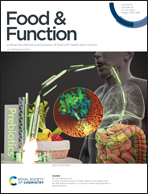Glucosamine alleviates zearalenone-induced damage to porcine trophectoderm cells by activating the PI3K/AKT signaling pathway†
Abstract
As one of the mycotoxins commonly found in feed and food, zearalenone (ZEA) mainly harms the reproductive functions of humans and animals. In our study, we investigated the protective effects of glucosamine (GlcN) on ZEA-induced apoptosis and oxidative damage of porcine trophectoderm (pTr) cells. Our results showed that 0.5 mmol L−1 GlcN significantly alleviated ZEA-induced decline in pTr cell viability. In addition, GlcN also significantly reversed other toxicity of ZEA to pTr cells, including G2/M phase arrest, DNA damage, reactive oxygen species (ROS) production, and barrier function disruption. Further studies indicated that GlcN can reduce apoptosis and autophagy in pTr cells in response to ZEA treatment. These results were confirmed by flow cytometry, transmission electron microscopy (TEM) and western blotting to detect the expressions of apoptosis and autophagy related proteins. Notably, GlcN activated the expressions of the PI3K/AKT signaling pathway related proteins, suggesting that its protective effect on pTr cells may be mediated by the PI3K/AKT signaling pathway. To demonstrate this mechanism, we used the PI3K/AKT pathway inhibitor wortmannin to pretreat pTr cells, and showed that the protective effect of GlcN on ZEA-induced pTr cytotoxicity was eliminated. In conclusion, GlcN was able to alleviate ZEA-induced toxic effects in pTr cells. This study also provides a theoretical basis for GlcN alleviating the adverse effects of ZEA on early embryo development and proved its potential application prospects.



 Please wait while we load your content...
Please wait while we load your content...